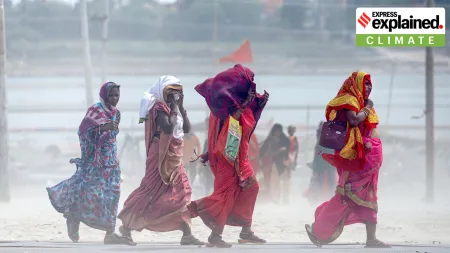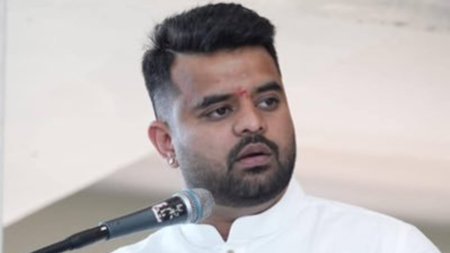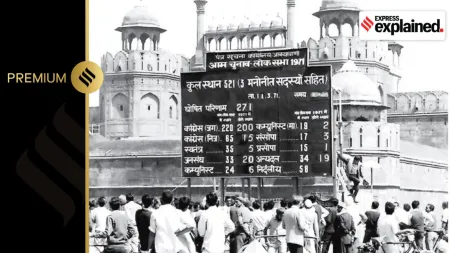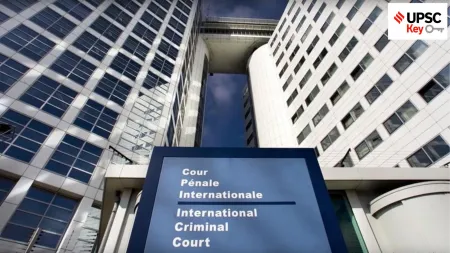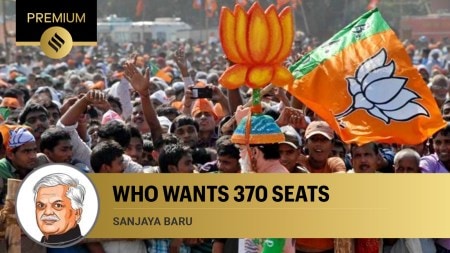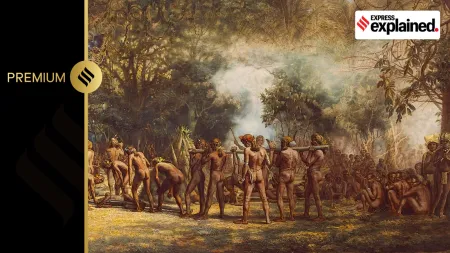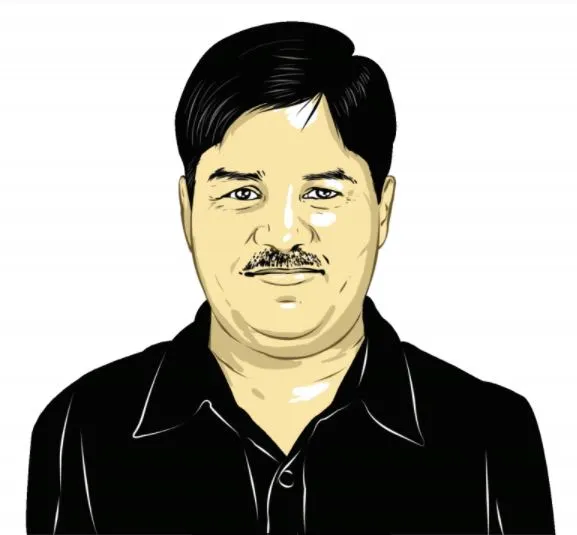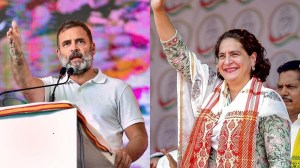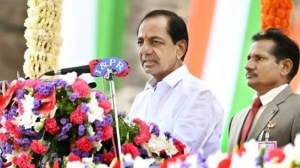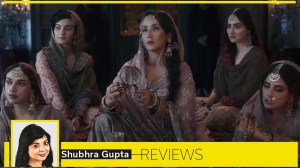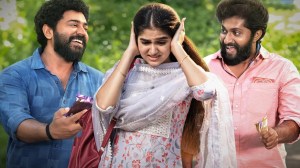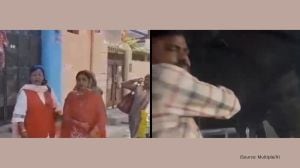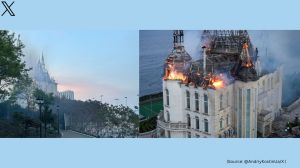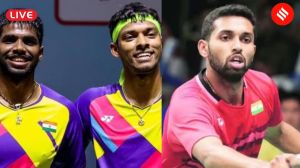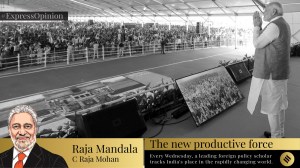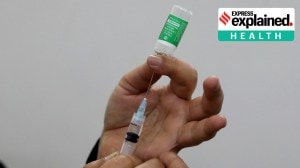- India
- International
When Election Commission overcame ‘impossible’ challenge, held second Lok Sabha election on time
1957 Lok Sabha elections: Constituencies were redrawn after delimitation; new states and boundaries came after reorganisation; a new ballot paper used. Here is Part 2 of our new series on the history of India’s Lok Sabha elections.
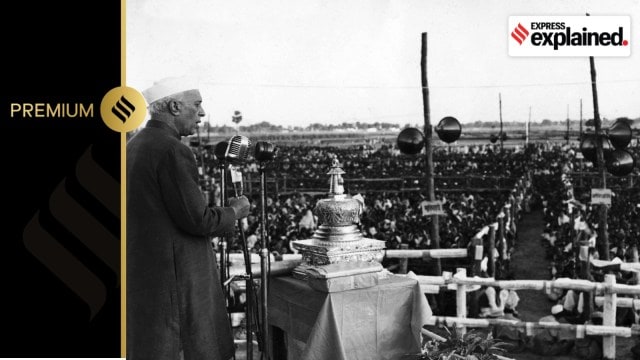 Prime Minister Jawaharlal Nehru addresses a public meeting at Nalanda district in Bihar, on January 12, 1957. (Photo credit: Press Information Bureau/Nehru Memorial Museum and Library Society)
Prime Minister Jawaharlal Nehru addresses a public meeting at Nalanda district in Bihar, on January 12, 1957. (Photo credit: Press Information Bureau/Nehru Memorial Museum and Library Society)If India’s first Lok Sabha election was, among other things, an act of faith, the second was a race against time.
Administrative challenges
The elections of 1957 presented formidable administrative challenges. The Delimitation Commission was constituted in 1952 to redraw constituencies based on data from the 1951 Census. Also, the States Reorganisation Commission led by Justice Fazl Ali had made its recommendations in 1955 (which were implemented in 1956) — thus, the boundaries of states too, were different from those during the first Lok Sabha election (1951-52).
In 1956, it looked as though the election could be delayed. On May 11 that year, Prime Minister Jawaharlal Nehru told Lok Sabha, “So far as the Election Commission is concerned, they are always preparing for the next step. The difficulty comes in when the new constituencies will have to be formed because of new states and for other reasons. So far as the government are concerned, they are anxious to have the elections as usual in March next (1957).”
The “difficulty” arising out of the reorganisation of states was very real and big. India had 27 states in 1951-52 — nine Part-A states (provinces of British India ruled by the Governor and with an elected state legislature), eight Part-B states (former princely states or groups of princely states governed by a Rajpramukh), and 10 Part-C states (provinces of British India governed by a Chief Commissioner who was appointed by the President, and some princely states).
In 1957, there were 14 states and six Union Territories. Elections were to be held for 494 Lok Sabha seats in 403 constituencies, including 91 seats with double members (one general category, the other from a Scheduled Caste/ Tribe), and 3,102 state Assembly seats in 2,518 constituencies (584 had double members).

There was another tight deadline to meet. Elections to the posts of President and Vice-President had to be held before May 13, 1957. This meant the Lok Sabha elections would have to be completed by the end of March 1957 — any delay would require an amendment to the Constitution.
Chief Election Commissioner Sukumar Sen wrote of the challenge and the EC’s determination to meet it: “Influential sections of public opinion were more or less convinced that it was an impossible task and that the elections would have to be postponed by a year or so and…life of the legislatures extended accordingly by an amendment of the Constitution…
“The Commission considered that it would be setting up a very bad precedent…if, merely because of certain temporary though formidable difficulties, the country was forced to amend its Constitution and extend the terms of the very first legislative bodies that had been set up under it.”
So, in the spring of 1957, the EC achieved the “impossible”: elections were held across the country in just over a fortnight.
The political landscape
As in 1952, the Congress was far ahead of the field. The Communist Party of India (CPI) and Praja Socialist Party (PSP) were the only major forces in the Opposition. The Bharatiya Jana Sangh (BJS), precursor of the BJP, was still trying to come into its own.
By 1957, leaders who might have mounted a political challenge to Nehru were no longer alive — Dr Syama Prasad Mookerjee had passed away in 1953, and Dr B R Ambedkar in 1956. The Gandhian J B Kripalani had merged his KMPP with Jayaprakash Narayan’s Socialist Party to form the PSP and take on the Congress. However, JP later moved away from active politics and aligned with Vinoba Bhave to campaign for his Bhoodan Movement, a voluntary land reform movement, and Sarvodaya programme for the uplift of all classes in society.
Just before the election, Nehru faced a setback when Chakravarti Rajagopalachari, the last Governor General of India and a former Chief Minister of Madras, left to form the Indian National Democratic Congress. The party, however, failed to make an impact in the election, and Rajaji later formed the Swatantra Party.
‘Modern’ ballot papers
A total 19.36 crore voters — excluding Jammu and Kashmir, Andamans, and Lakshadweep’s Minicoy Island — were enrolled to vote between February 24 and March 14, 1957. Some constituencies in the hilly regions of Punjab and Himachal Pradesh, which was a Union Territory at the time, were cut off by snow, and could vote only in June and July. A total 9.21 crore women were enrolled to vote, and in the rural areas, separate polling stations were set up for women in purdah.
Some 9.26 lakh polling personnel, 2.73 lakh policemen, and 1.68 lakh chowkidars were deployed for the election. More than 21 lakh ballot boxes were used — but since some boxes were recycled from 1951-52, only 4.56 lakh new boxes had to be arranged, reveals the 1957 Election Commission report.
In the first Lok Sabha election, voters were given ballot papers the size of a Re 1 currency note, and asked to drop it in the designated ballot box for the candidate of their choice. That system changed in 1957 — a new type of ballot paper was introduced, which remained in use until the arrival of electronic voting machines (EVMs).
On August 22, 1956, Minister for Law and Minority Affairs Charu Chandra Biswas told Lok Sabha: “The Election Commission has under consideration the question of introduction of a system of voting called the marking system… A ballot paper will bear the names (and, if possible, symbols) of all candidates. The elector will secretly place a mark against the name of the candidate of his choice.”
The new ballot paper contained a serial number and the name of each candidate, along with their party affiliation and election symbol. The Security Press in Nashik printed 57.93 crore ballot papers for the 1957 election.
Like in 1951-52, voters participated with enthusiasm. The EC report reveals that at a polling station in Bihar, an old woman demanded to see “Pandit Nehru” before voting. At a polling station in UP, a few voters refused to vote for anyone but “Gandhiji” and “Nehruji”. In Madras, a voter insisted on voting for the CEC, saying, “I want to vote for Shri Sukumar Sen only and not for the candidate of any of the parties. All these parties have been harassing me (with propaganda).”
However, the overall polling percentage in 1957 fell to 47.54% from the 51.15% in the first Lok Sabha election. The highest turnout (75.68 %) was recorded in Kottayam in Kerala, while Kangra, which was then in Punjab, had the lowest turnout (16.94 %).
A sweep for Congress
Despite the rumblings within the Congress, the party ended up stronger after the election, with its vote share going up from 44.99% in 1952 to 47.78% in 1957. The party won 371 seats, seven more than in 1952. The CPI came a distant second with 27 seats — nine in Kerala and six in West Bengal. Of the 45 women who contested, 22 won.
Nehru won his second straight election from Phulpur. After losing from Bombay in 1952, Morarji Desai won from Surat, Lal Bahadur Shastri from Allahabad (now Prayagraj) and Feroze Gandhi from Rae Bareli.
Atal Bihari Vajpayee was the BJS candidate from Mathura, Lucknow, and Balrampur, but won only in Balrampur. Acharya Kripalani (PSP) won from Sitamarhi, while his wife Sucheta won from New Delhi as a Congress nominee. Vijayaraje Scindia, who would later play a key role in the BJS-BJP, won as a Congress candidate from Guna.
Prominent among the losers were V V Giri, who would later become President — he came in third at the two-member Parvathipuram seat. Ram Manohar Lohia contested from Chandauli as an Independent and lost.
On April 17, 1957, Nehru, 68, took oath as Prime Minister. His popularity was undiminished, and the Congress under him was the strongest it had been since Independence. But this, 1957-1962, would be his last full term as Prime Minister.
More Explained
EXPRESS OPINION
May 01: Latest News
- 01
- 02
- 03
- 04
- 05


